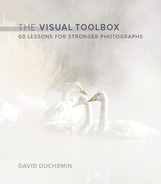Lesson 19. Try It in Black and White
Color is extremely seductive; it has an enormous pull on both our eyes and our emotions. In broad strokes, the brighter and more saturated the color, the greater the pull on the eye, and as there can only be so much impact in a photograph, it is often those elements of brighter color that get all our attention, pulling the eye of the viewer away from other significant elements. Lines and moments often get overpowered by color, and there are times when the colors and how we respond emotionally to them conflict with the story in the photograph. If, for example, you’re creating a photograph about a tragic event, the presence of happy colors like bright yellow can pull our emotions in the opposite direction, creating a photograph that creates a cognitive or emotional dissonance in the reader.
Leica M(240), 21mm, 1/3s @ f/13, ISO 400
The colours in this scene were striking, and in the end the photograph I printed is a colour image, but what I gained in mood I lost a little in the power of the lines. Everything is a give and take in photography, and in this case the mood was more important to me. But man, look at those lines!
Fuji XE-1, 14mm, 125 seconds @ f/16, ISO 200
Pulling the color from this scene in Italy allows the texture and tones to play in a stronger way than they do with the color present. Sure, you lose some of the mood but there’s a give and take in each decision. Knowing which to use, and when, comes as we learn to see in both color and black and white.
There are a lot of reasons to keep the color in a photograph, and just as many to render it in black and white, not the least of which is personal preference or in keeping with the visual cohesiveness of a series. I am not suggesting that you pull the color from an image that fails on other counts in order to fix it. My suggestion is to use a conversion to monochrome as a way of helping you see your own work with greater clarity, free of the pull of color.
I use Lightroom exclusively and it’s an easy matter to apply one of several black and white presets to my work, evaluate it, and then return it to color if that’s my intent for the image. Looking at the black and white rendering, I’m asking myself questions like these:
• What does the image gain without color?
• Is my eye now drawn toward, or away from, my subject?
• Are there lines, textures, or the gesture of a moment that are now stronger for the lack of color?
• How does the mood of the image change?
• How does the balance change?
• What changes does this suggest when I return the color to the photograph?


